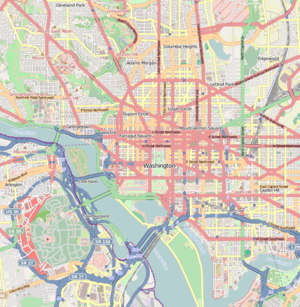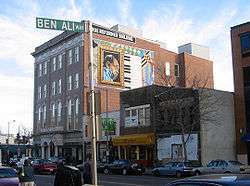True Reformer Building
The True Reformer Building is an historic building constructed for the True Reformers, an African American organization founded by William Washington Browne. The building is at 1200 U Street, Northwest, Washington, D.C. in the U Street Corridor (Cardozo/Shaw) neighborhood. It was designed by John Anderson Lankford. The building was commissioned by the Grand United Order of True Reformers in 1902.[3] It was dedicated on July 15, 1903.[4]
True Reformer Building | |
 | |
 | |
| Location | 1200 U Street, NW, Washington, District of Columbia |
|---|---|
| Coordinates | 38°55′0″N 77°1′43″W |
| Area | 0.3 acres (0.12 ha) |
| Built | 1903 |
| Architect | John Anderson Lankford |
| Part of | Greater U Street Historic District[1] (ID93001129) |
| NRHP reference No. | 88003063[2] |
| Added to NRHP | January 9, 1989 |
History
The Grand United Order of True Reformers started as a temperance organization and in 1876 Browne was invited to spearhead a new branch of the movement in Richmond, Virginia.[5] When interest in the organization began to decrease Browne began shifting the organization from a temperance society to an insurance organization, a movement that required Browne to move to Richmond in 1880.[6] Over time the organization grew in size to where it managed a bank, ran a newspaper entitled the Reformer, owned several properties, and at one point in time was the largest black fraternal society and black-owned business in the United States.[6][7]
During the True Reformer Building's dedication in 1903, the Reverend William Lee Taylor stated that the goal was to "put up a building in Washington that would reflect credit upon the Negro race."[8] It is significant that the building took shape as a result of an African American architect, with African American financing, and built with African American hands. The Reformer Building was the first building in the United States to be designed, financed, built, and owned by the African American community after Reconstruction. It was designed by John Anderson Lankford, the city’s first African-American registered architect. The building was commissioned by the Grand United Order of True Reformers in 1902 and was dedicated on July 15, 1903.
In 1909 a book was published about the organization's first 25 years.[9]
During Browne's life the organization enjoyed success, however it suffered crippling setbacks in 1910 due to employee embezzlement and businesses defaulting on large unsecured loans, causing its collapse.[10]
A.W. Holmes was president of the group in 1911 as retrenchment was sought and board membership included Adolphus Humbles of Lynchburg, Virginia.[11]
Ownership changes

The Knights of Pythias bought the building in 1917.[12]
From 1937 to 1959, the Boys Club of the Metropolitan Police of the District of Columbia, leased the building; Eleanor Roosevelt rededicated the building.[13]
Other tenants have included: Washington Conservancy, the DC Chapter of the National Negro Business League, the First Separate Battalion. Duke Ellington gave his first performance here.[8]
The building was listed on the National Register of Historic Places in 1989. The Public Welfare Foundation bought it in 1999. It was renovated from the winter of 2000 until February 2001 according to designs by Sorg & Associates.[14]
Public art
G. Byron Peck's mural to Duke Ellington on the side of the building used to overlook the U Street Metro station.[12] It was completed in 1997, and located on the sidewall of Mood Indigo.[15] It was relocated to the True Reformer Building.[16] The mural was removed in 2012 for restoration.[17] Its removal was made permanent in 2013 due to damage. On 3rd May 2019 a replica of the mural was returned to the building [18] [19]
References
- Trieschmann, Laura V.; Sellin, Anne; Callcott, Stephen (November 1998), National Register of Historic Places Registration Form: Greater U Street Historic District (PDF), retrieved March 31, 2015.
- "National Register Information System". National Register of Historic Places. National Park Service. March 13, 2009.
- "Grand Fountain of the United Order of True Reformers". www.encyclopediavirginia.org. Retrieved 4 February 2018.
- "Archived copy". Archived from the original on 2012-06-06. Retrieved 2011-11-03.CS1 maint: archived copy as title (link)
- Williams, Michael Paul. "William Washington Browne". Richmond Times Dispatch. Retrieved 10 August 2015.
- Watkinson, James D. "William Washington Browne (1849–1897)". Encyclopedia Virginia. Retrieved 10 August 2015.
- Mjagkij, Nina (2001). Organizing Black America. Routledge. p. 220. ISBN 978-0815323099. Retrieved 10 August 2015.
- "Duke Ellington's Washington: Virtual Tour of Shaw: Theaters". www.pbs.org. Retrieved 4 February 2018.
- William Patrick Burrell (1909). Twenty-five Years History of the Grand Fountain of the United Order of True Reformers, 1881-1905. Grand Fountain, United Order of True Reformers.
- Fahey, David M. (2013). "Why some black lodges prospered and others failed: the Good Templars and the True Reformers". Ethnic and Racial Studies. 36 (2): 337–352. doi:10.1080/01419870.2012.676196.
- "Indianapolis Recorder 11 March 1911 — Hoosier State Chronicles: Indiana's Digital Historic Newspaper Program". newspapers.library.in.gov.
- "Archived copy". Archived from the original on 2012-05-12. Retrieved 2011-11-03.CS1 maint: archived copy as title (link)
- https://npgallery.nps.gov/NRHP/GetAsset/NRHP/88003063_text
- "Archived copy". Archived from the original on 2011-11-02. Retrieved 2011-11-03.CS1 maint: archived copy as title (link)
- "Archived copy". Archived from the original on 2011-12-22. Retrieved 2011-12-12.CS1 maint: archived copy as title (link)
- http://murallocator.org/2010/01/duke-ellington-mural/
- "Duke Ellington Still Absent from the True Reformer Building on U Street". Retrieved 4 February 2018.
- https://www.dchistory.org/event/dukeellingtonmural/
- https://www.popville.com/2019/05/duke-ellington-is-back-on-u-street/